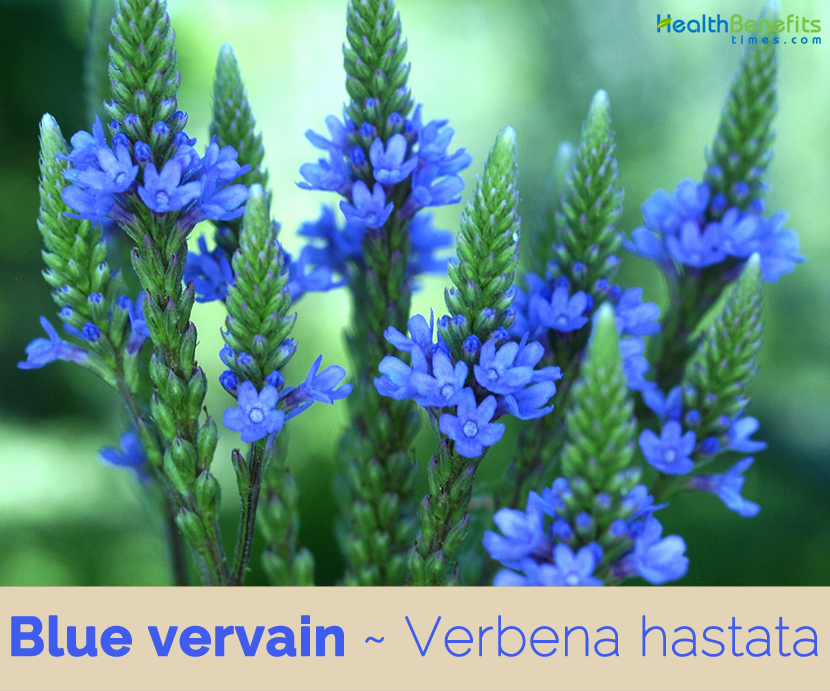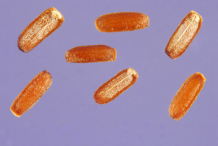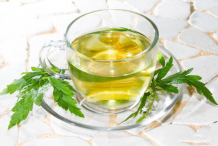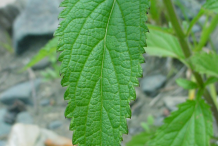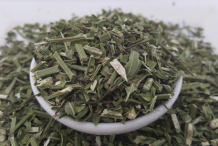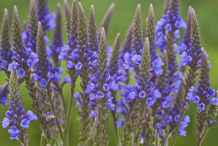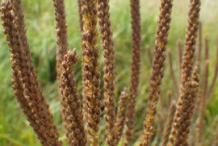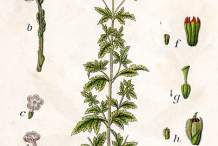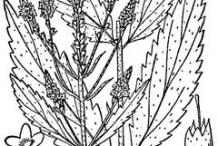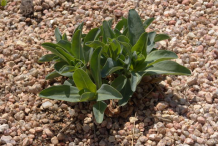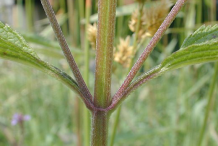| Blue vervain Quick Facts |
| Name: |
Blue vervain |
| Scientific Name: |
Verbena hastata |
| Origin |
Americas, the Mediterranean region and the Near East |
| Colors |
Reddish brown |
| Shapes |
Oblong and triangular convex |
| Taste |
Slightly bitter and astringent |
| Health benefits |
Keeps Nervous System Healthy, Eases Menstruation, Detoxifies the Body, Anti-parasitic Activity, Oral Health, For A Healthy Gut, Treats Respiratory Disorders, Breastfeeding Mothers, Relieves Pain, Natural Mood Enhancer, Good For Women’s Health, Good for Kidney Stones, Relieves Depression |
Blue vervain scientifically known as Verbena hastata is a flowering plant in the vervain family, Verbenaceae. The plant is native to wet meadows, wet river bottomlands, stream banks, slough peripheries, fields and waste areas of Americas, the Mediterranean region and the Near East. Few of the common names of the plant are Simpler’s Joy, American blue vervain, Blue Vervain, Herb of Grace, Herba veneris, Swamp Verbena, Vervain, Wild hyssop, Wild Vervain, American vervain, false vervain, ironweed, swamp vervein and blue verbena. Genus name comes from a Latin name used for some plants in religious ceremonies and also in medicine. Specific epithet means spear-shaped. The name Vervain is derived from the Celtic ferfaen, from fer (to drive away) and faen (a stone), as the plant was much used for affections of the bladder, especially calculus. Another derivation is given by some authors from Herba veneris, because of the aphrodisiac qualities attributed to it by the Ancients. Blue vervain can be easily distinguished from other types of vervain because of its distinctive color.
Plant Description
Blue vervain is a slender and an erect perennial plant that grows about 2 to 6 feet high. The plant is found growing in river bottom prairies, moist meadows near floodplain woodlands, soggy thickets, borders of rivers and ponds, marshes, ditches, fence rows, and pastures. This plant adapts readily to degraded wetlands and other disturbed areas, but it can be found in higher quality habitats as well. Normally the plant prefers rich, well-drained moderately rich soil and commonly grows in streambeds and moist, low-lying fields and wetlands. The plant has fibrous root and green to reddish stems that are four-angled, often with white appressed hairs.
Leaves
Leaves of blue vervain are narrow, opposite, lanceolate (or oblong) reaching anywhere from 3 cm to 17 cm long and on average 5 cm wide with a sharply pointed tip, coarsely toothed edges and a short stalk. They are dark green, have a rough texture to the touch and are strongly veined. Upper surface is rough-textured, the lower finely short-hairy. Margins are double-toothed or serrated.
Flower & Fruit
Upper stems terminate in a panicle of flowering spikes. Each spike is 2 to 5 inches long and densely packed all around with numerous reddish blue or violet flowers. The flowers at the bottom of the spike bloom first, and the ring of flowers appears to advance upward to the tips of the spike. Each flower is a little less than ¼ inch across with 5 petals fused at the base forming a short tube. Inside the tube are 4 stamens and a short style. The calyx is green to purplish, shorter than the floral tube, about 1/8 inch long, short hairy with 5 lobes. Spikes elongate as the plants mature, with flowers blooming near the tip and fruit forming below. Four nutlets are produced per flower and they are reddish brown, oblong, and triangular convex. The blooming period occurs from mid- to late summer, and lasts about 1½ months.
Other varieties
- Verbena Jamaicensis (Jamaica Vervain): It grows in Jamaica, Barbados, and other West Indian islands, bearing violet flowers. The juice is used in dropsy and for children as an anthelmintic and cooling cathartic. The Negroes use it as an emenagogue, and for sore and inflamed eyes. As a poultice, with wheat-flour, the bruised leaves are used for swelling of the spleen, and for hard tumors at their commencement.
- Lappulaceae (Burry Vervain): It is another popular West Indian herb, with pale blue flowers, is a vulnerary sub-astringent, being used even for very severe bleeding wounds in men and cattle, especially in Jamaica.
- hastata (Blue vervain, Wild Hyssop, Simpler’s Joy): It is indigenous to the United States, and is used unofficially as a tonic emetic, expectorant, etc., for scrofula, gravel, and worms. A fluid extract is prepared from the dried, over-ground portion.
- Urticifolia: The root, boiled in milk and water with the inner bark of Quercus Alba, is said to be an antidote to poisoning by Rhus Toxicodendron.
- Sinuata: An infusion of the root, taken as freely as possible, is said to be a valuable anti-syphilitic.
Health Benefits of Blue Vervain
Apart from the use of blue vervain seeds as food, leaves were also used by the Native Americans to prepare tea. This herbal tea is supposed to be useful for boosting liver health, for relief from arthritis symptoms, for reducing fever, and for treating certain digestive problems. Even today, blue vervain is used as an herbal remedy for various ailments. Let’s take a closer look at the numerous health benefits of blue vervain.
1. Keeps Nervous System Healthy
Soothing properties of blue vervain can efficiently treat a number of ailments, including nervous disorders, chronic anxiety, stress, and sleeplessness. Occasionally, our body’s release and management of hormones are less than optimal, and over time, this can result in significant health problems. A cup of blue vervain tea can calm our nerves and re-balance hormone levels, ensuring that our body can rest.(1)
2. Eases Menstruation
For women who suffer from severe periods, blue vervain can be a blessing. It has been known to reduce cramps and general discomfort, mainly for women who are bloated and cramping. Its effects on mood and depression can also soften the symptoms of menstruation, while its help in regulation of hormones will keep you balanced and functional.(2)
3. Detoxifies the Body
One of the oldest and most reliable uses of blue vervain is as a diuretic, as it encourages the release of urine from the body. It can help eliminate toxins from the system, as well as excess water, salts, and fat. It also helps protect the kidneys and the liver by reducing the presence of dangerous substances and toxins that accumulate there. If you have a bladder infection, blue vervain can be a highly effective remedy. (3)
4. Anti-parasitic Activity
Although intestinal worms and parasites aren’t as common as they used to be before proper food preparation guidelines and health advanced, the anti-parasitic nature of blue vervain is still relied on in some cultures and situations. The natural anti-parasitic nature of the herb means that you can remove or prevent the growth and development of any worms or parasites in your intestines, thus protecting your digestive health.(4)
5. Oral Health
Tannins present in blue vervain make it a very effective way to protect your overall oral health. Whether you have bleeding gums, mouth ulcers, bacterial infections, or any other unhealthy aspect of your oral health, blue vervain tea can quickly clear it up. Tannins function as antioxidants to promote healing and prevent further degradation to the tissue.(5)
6. For A Healthy Gut
The herb, in the form of tea, can be used as a natural drink to ease digestive disorders and keep the gut healthy. It has been a required remedy for numerous common problems affecting your tummy, including bloating, cramps, and flatulence. A natural remedy for vomiting and diarrhea, this herb is also known to boost nutrient absorption. Get rid of the worms and toxins from your stomach with this herb. The herb can be used as a good laxative as well. Research suggest that regular use of about 2 oz. to one quart of this vervain decoction can ease vomiting, thus relieving you from stomach pain. This herb decoction, when applied externally, is also known to cure piles.
7. Treats Respiratory Disorders
If you regularly suffer from chest congestion, colds, chronic bronchitis, sore throats or respiratory inflammation, blue vervain tea can be simple and pleasant options for clearing up your tracts and eliminating irritation. Coughs and colds from Rome to California have been cured with blue vervain, as it also acts as an expectorant, helping to expel mucus and phlegm that have gathered in the respiratory tracts.(6)
8. Breastfeeding Mothers
Several women struggle to produce enough milk for their baby, and this is completely natural in many cases. However, blue vervain can help stimulate the production of milk in the breast, ensuring that your baby has all of the nutrients it needs in that crucial period of growth.(7)
9. Relieves Pain
Blue vervain can act as a powerful painkiller. It seems to be mainly effective on arthritic pain and the pain from kidney stones. Organic compounds present in blue vervain can numb certain areas and stop the pain from registering in those nerves, thus giving you some relief. The anti-inflammatory properties of the herb are the perfect complement to this pain relief, as it will also reduce swelling and inflammation, such as in cases of gout, arthritis, or inflammation in the gastrointestinal system.(8)
10. Natural Mood Enhancer
Power of vervain to ease the feelings related with anxiety and stress is well-acknowledged. Drinking a cup of vervain tea has a soothing effect on the central nervous system that in turn triggers a sensation of calmness and relaxation. Thus, this herb has been extensively used to aid people suffering from depression and stress. Vervain is also supposed to be effective in easing post-traumatic stress as well as insomnia. Just drink a cup of warm vervain tea 30 minutes before you hit your bed for a good night’s sleep. A natural tranquilizing agent, it is a good antidote for restlessness and irritation.
11. Good For Women’s Health
Packed with strong mood improving properties, this herb helps in easing the anxiety and mood swings experienced by women during the premenstrual period. Vervain is also used to induce menstrual cycle in women whose periods has been delayed.
The herb has the potential to trigger uterine contractions, and hence, it can be used to induce labor and accelerate child birth. Research also indicates that using vervain aids in improving lactation levels naturally after delivery.
12. Good for Kidney Stones
Just prepare an infusion by steeping 1 tbsp dry blue vervain leaves in one pint boiling water for 10 minutes. Consume about 6 tbsp every day, spread over 6 doses, to get rid of urinary bladder infections and kidney stones.
13. Relieves Depression
Blue vervain has commonly been turned to in the past for people suffering from depression and unpredictable moods. This relaxing and uplifting herb can promote positive thinking, stimulate the release of neurotransmitters like dopamine and serotonin, and improve your mood by clearing your mind of worry.
https://www.youtube.com/watch?v=f5m_-d1XiFs
Traditional uses and benefits of Blue vervain
- Leaves and roots are antiperiodic, diaphoretic, emetic, expectorant, tonic, vermifuge and vulnerary.
- Roots are more active than the leaves.
- Plant is used in the treatment of stomach aches, gravel, worms and scrofula.
- An infusion of the roots, leaves or seeds has been used in the early stages of fevers.
- Snuff made from the dried flowers has been used to treat nose bleeds.
- It is said to be useful in intermittent fevers, ulcers, ophthalmia, pleurisy, etc., and to be a good galactogogue.
- It is still used as a febrifuge in autumn fevers.
- Dried, powdered flowers were once used as a snuff for nosebleeds.
- Externally, this plant can be used as a poultice to help heal wounds and hemorrhoids.
- Leaves and roots are a valuable alternative medicine used by medical herbalists for their patients as an antidiarrheal, analgesic, anthelmintic, antiperiodic, astringent.
- It is useful in intermittent fevers, ulcers, pleurisy, scrofula, gravel, easing pain in the bowels and expelling worms.
- As a medicinal poultice it is good in headache and rheumatism.
- An infusion of Vervain is a good galactogogue and used for female obstructions, after pains and taken as a female tonic.
- Infusion is also used to help pass kidney stones and for infections of the bladder.
- Vervain tea is used as a sudorific and taken for colds and coughs.
- It is also useful for insomnia and other nervous conditions.
Culinary Uses
- Seed can be roasted and ground into a powder or used whole as a piñole.
- Leaves are used as a tea substitute.
- Leaves can be made into a tea or tossed into salads, soups, etc.
- Flowers can be tossed on top of a salad and eaten.
Precautions
- When used in larger concentrations, such as in medicinal supplements, mild skin rashes may also appear.
- As with any herbal remedy, it can interact with certain medications and other treatments, so it is always wise to speak with a doctor before adding it to your regimen.
- Excessive consumption of this herb can trigger vomiting, leading to dehydration.
- Pregnant women are advised against consuming the same during the initial stages of pregnancy.
Method of preparing Vervain Tea
If you want to make vervain tea, it is best to purchase vervain tea bags, rather than preparing your own dried leaves and flowers from this plant.
- Step 1 – Bring a saucepan of water to a boil.
- Step 2 – Add 1 vervain tea bag to a teapot or tea infuser.
- Step 3 – Pour over the boiling water and allow the tea to steep for 3-4 minutes.
- Step 4 – Remove the teabag and add honey, lemon or stevia to improve the flavor, if desired.
References:
https://www.itis.gov/servlet/SingleRpt/SingleRpt?search_topic=TSN&search_value=32071#null
https://davesgarden.com/guides/pf/go/2302/
https://npgsweb.ars-grin.gov/gringlobal/taxonomydetail.aspx?id=41157
https://pfaf.org/USER/Plant.aspx?LatinName=Verbena+hastata
https://www.cabi.org/isc/datasheet/117793
http://www.missouribotanicalgarden.org/PlantFinder/PlantFinderDetails.aspx?kempercode=z370
https://plants.usda.gov/core/profile?symbol=veha2
http://www.theplantlist.org/tpl1.1/record/kew-212339
https://botanical.com/botanical/mgmh/v/vervai08.html
https://en.wikipedia.org/wiki/Verbena_hastata
https://gobotany.newenglandwild.org/species/verbena/hastata/
Comments
comments


